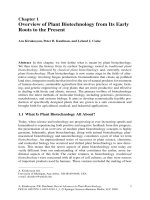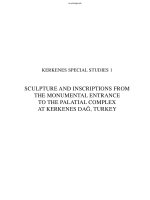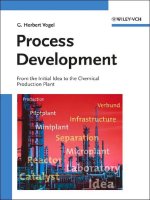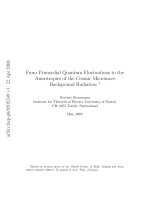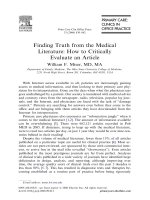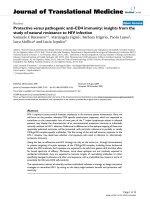process development from the initial idea to the chemical production plant
Bạn đang xem bản rút gọn của tài liệu. Xem và tải ngay bản đầy đủ của tài liệu tại đây (3.92 MB, 478 trang )
G. Herbert Vogel
Process Development
Process Development. From the Initial Idea to the Chemical Production Plant. G. Herbert Vogel
Copyrightª2005WILEY-VCHVerlagGmbH&Co.KGaA,Weinheim
ISBN: 3-527-31089-4
G. Herbert Vogel
Process Development
From the Initial Idea to the
Chemical Production Plant
Prof. Dr. G. Herbert Vogel
TU Darmstadt
Ernst Berl Institute of
Chemical Engineering and
Macromolecular Science
Petersenstraße 20
64287 Darmstadt
Germany
All books published by Wiley-VCH are carefully
produced. Nevertheless, authors, editors, and
publisher do not warrant the information contained
in these books, including this book, to be free of
errors. Readers are advised to keep in mind that
statements, data, illustrations, procedural details or
other items may inadvertently be inaccurate.
Library of Congress Card No.: applied for
British Library Cataloguing-in-Publication Data:
A catalogue record for this book is available from
the British Library.
Bibliographic information published by
Die Deutsche Bibliothek
Die Deutsche Bibliothek lists this publication in the
Deutsche Nationalbibliografie; detailed
bibliographic data is available in the Internet at
<>
ª 2005 Wiley-VCH Verlag GmbH & Co. KGaA,
Weinheim
All rights reserved (including those of translation
into other languages). No part of this book may be
reproduced in any form – by photoprinting,
microfilm, or any other means – nor transmitted
or translated into a machine language without
written permission from the publishers. Registered
names, trademarks, etc. used in this book, even
when not specifically marked as such, are not to be
considered unprotected by law.
printed in the Federal Republic of Germany
printed on acid-free paper.
Composition Mitterweger & Partner
Kommunikationsgesellschaft mbH, Plankstadt
Printing betz-druck GmbH, Darmstadt
Bookbinding Litges & Dopf Buchbinderei GmbH,
Heppenheim
ISBN-13: 978-3-527-31089-0
ISBN-10: 3-527-31089-4
For my children
Birke, Karl, Anke and Till
Preface
The idea behind this book is to facilitate the transition of academics from university to
the chemical industry. It will enable not only all bachelor and doctoral graduates in
natural sciences and engineering, but also economics students, who will shortly enter
the chemical industry to make a smooth start to their careers and to hold competent
discussions with experienced industrial chemists and engineers.
This book is intended both for experienced workers in the industry who are looking
for a concise reference work as a guideline for problem solving, and for students stu-
dying technical chemistry as an aid to revision.
Chapters 3 to 6 describe the development and evaluation of production processes
and the execution of projects from the chemist’s viewpoint. The various aspects che-
mical, engineering, materials science, legal, economic, safety, etc. that must be taken
into account prior to and during the planning, erection, and startup of a chemical plant
are treated.
The necessary basic knowledge is provided in Chapter 2: The Chemical Production
Plant and its Components. It deals with important subdisciplines of technical chemi-
stry such as catalysis, chemical reaction engineering, separation processes, hydrody-
namics, materials and energy logistics, measurement and control technology, plant
safety, and materials selection. Thus, it acts as a concise textbook within the book
that saves the reader from consulting other works when such information is requi-
red. A comprehensive appendix (mathematical formulas, conversion factors, thermo-
dynamic data, material data, regulations, etc.) is also provided.
This book is based on the industrial experience that I gathered at BASF AG, Lud-
wigshafen from 1982 to 1993 in the development, planning, construction, and startup
of petrochemical production plants. Therefore, the choice of topics and the approach
are necessarily subjective. Here, I am especially grateful to my mentors in these sub-
jects, Dr. Gerd Du¨mbgen and Dr. Fritz Thiessen.
This book could not have been realized without the help of Dr Ing. Gerd Kaibel
(BASF AG, Ludwigshafen), who made available his extensive industrial experience
and provided Chapter 2.3 on thermal and mechanical separation processes.
I thank Prof. Dr. Wilfried J. Petzny (formerly EC Erdo¨lchemie, Cologne) for chek-
king the manuscript, and for constructive criticism and comments, which have gra-
tefully been incorporated.
Process Development. From the Initial Idea to the Chemical Production Plant. G. Herbert Vogel
Copyright ª 2005 WILEY-VCH Verlag GmbH & Co. KGaA, Weinheim
ISBN: 3-527-31089-4
VII
Finally, I am grateful to Dieter Bo¨ttiger (TU Darmstadt) for preparing numerous
figures, and my eldest daughter Birke Vogel for proofreading the manuscript.
Any errors in the book are entirely my responsibility.
Darmstadt and Ludwigshafen, February 2005 G. Herbert Vogel
ForewordVIII
Contents
1 Introduction 1
1.1 The Goal of Industrial Research and Development 3
1.2 The Production Structure of the Chemical Industry 4
1.3 The Task of Process Development 11
1.4 Creative Thinking 12
2 The Chemical Production Plant and its Components 13
2.1 The Catalyst 16
2.1.1 Catalyst Performance 20
2.1.1.1 Selectivity 20
2.1.1.2 Activity 20
2.1.1.3 Lifetime 22
2.1.1.4 Mechanical Strength 25
2.1.1.5 Production Costs 25
2.1.2 Characterization of Catalysts 28
2.1.2.1 Chemical Composition 28
2.1.2.2 Nature of the Support Material 29
2.1.2.3 Promoters 29
2.1.2.4 Phase Composition 29
2.1.2.5 Particle Size 30
2.1.2.6 Pore Structure 30
2.1.2.7 Surface Structure 30
2.1.2.8 Byproducts in the Feed 31
2.1.3 Kinetics of Heterogeneous Catalysis 31
2.1.3.1 Film Diffusion 32
2.1.3.2 Pore Diffusion 35
2.1.3.3 Sorption 38
2.1.3.4 Surface Reactions 42
2.1.3.5 Pore Diffusion and Chemical Reaction 45
2.1.3.6 Film Diffusion and Chemical Reaction 50
2.2 The Reactor 51
2.2.1 Fundamentals of Chemical Reaction Technology 52
2.2.1.1 Ideal Reactors 56
2.2.1.2 Reactors with Real Behavior 60
Process Development. From the Initial Idea to the Chemical Production Plant. G. Herbert Vogel
Copyright ª 2005 WILEY-VCH Verlag GmbH & Co. KGaA, Weinheim
ISBN: 3-527-31089-4
IX
2.2.1.3 Nonisothermal reactors 68
2.2.1.4 Design of Reactors 74
2.3 Product Processing (Thermal and Mechanical
Separation Processes)
80
2.3.1 Heat Transfer, Evaporation, and Condensation 80
2.3.1.1 Fundamentals 80
2.3.1.2 Dimensioning 86
2.3.2 Distillation, Rectification 94
2.3.2.1 Fundamentals of Gas–Liquid Equilibria 94
2.3.2.2 One-Stage Evaporation 99
2.3.2.3 Multistage Evaporation (Rectification) 102
2.3.2.4 Design of Distillation Plants 108
2.3.4.5 Special Distillation Processes 132
2.3.3 Absorption and Desorption, Stripping, Vapor-Entrainment
Distillation
136
2.3.3.1 Fundamentals 136
2.3.3.2 Dimensioning 137
2.3.3.3 Desorption 142
2.3.3.4 Vapor-Entrainment Distillation 142
2.3.4 Extraction 143
2.3.4.1 Fundamentals 144
2.3.4.2 Dimensioning 146
2.3.4.3 Apparatus 154
2.3.5 Crystallization 155
2.3.5.1 Fundamentals 156
2.3.5.2 Solution Crystallization 159
2.3.5.3 Melt Crystallization 161
2.3.5.4 Dimensioning 164
2.3.6 Adsorption, Chemisorption 165
2.3.7 Ion Exchange 167
2.3.8 Drying 167
2.3.9 Special Processes for Fluid Phases 169
2.3.10 Mechanical Processes 170
2.4 Pipelines, Pumps, and Compressors 172
2.4.1 Fundamentals of Hydrodynamics 172
2.4.2 One-phase Flow in Pipelines 174
2.4.3 Pumps 179
2.4.4 Compressors 184
2.5 Energy Supply 186
2.5.1 Steam and Condensate System 186
2.5.2 Electrical Energy 188
2.5.3 Cooling Water 188
2.5.4 Refrigeration 189
2.5.5 Compressed Air 189
2.6 Product Supply and Storage 190
ContentsX
2.7 Waste Disposal [Rothert 1992] 192
2.7.1 Off-Gas Collection System and Flares 192
2.7.2 Combustion Plants for Gaseous and Liquid Residues 192
2.7.3 Special Processes for Off-Gas Purification 194
2.7.4 Wastewater Purification and Disposal 197
2.7.4.1 Clarification Plant 197
2.7.4.2 Special Processes for Wastewater Purification 199
2.7.5 Slop System 201
2.8 Measurement and Control Technology 202
2.8.1 Metrology 202
2.8.1.1 Temperature Measurement 202
2.8.1.2 Pressure Measurement 205
2.8.1.3 Measuring Level 205
2.8.1.4 Flow Measurement 206
2.8.2 Control Technology 211
2.8.3 Control Technology 218
2.9 Plant Safety 220
2.10 Materials Selection 224
2.10.1 Important Materials and their Properties 226
2.10.1.1 Mechanical Properties and Thermal Stability 228
2.10.1.2 Corrosion Behavior 229
2.10.2 Metallic Materials 233
2.10.3 Nonmetallic Materials 234
3 Process Data 237
3.1 Chemical Data 239
3.1.1 Heat of Reaction 239
3.1.2 Thermodynamic Equilibrium 240
3.1.3 Kinetics 245
3.1.4 Selectivity and Conversion as a Function of the Process Parameters 257
3.2 Mass Balance 261
3.3 Physicochemical Data 263
3.3.1 Physicochemical Data of Pure Substances 264
3.3.2 Data for Mixtures 265
3.4 Processing 267
3.5 Patenting and Licensing Situation 267
3.6 Development Costs 270
3.7 Location 271
3.8 Market Situation 272
3.9 Raw Materials 273
3.10 Plant Capacity 276
3.11 Waste-Disposal Situation 277
3.12 End Product 278
Contents XI
4 Course of Process Development 279
4.1 Process Development as an Iterative Process 281
4.2 Drawing up an Initial Version of the Process 284
4.2.1. Tools used in Drawing up the Initial Version of the Process 287
4.2.1.1 Data Banks 287
4.2.1.2 Simulation Programs 288
4.2.1.3 Expert Systems 292
4.3. Checking the Individual Steps 294
4.4 The Microplant: The Link between the Laboratory and the Pilot Plant 296
4.5 Testing the Entire Process on a Small Scale 297
4.5.1 Miniplant Technology 297
4.5.1.1 Introduction 297
4.5.1.2 Construction 298
4.5.1.3 The Limits of Miniaturization 300
4.5.1.4 Limitations of the Miniplant Technology 302
4.5.2 Pilot Plant 302
5 Planning, Erection, and Start-Up of a Chemical Plant 305
5.1 General Course of Project Execution 307
5.2 Important Aspects of Project Execution 314
5.2.1 Licensing 314
5.2.2 Safety Studies 317
5.2.3 German Industrial Accident Regulation (Sto¨rfallverordnung) 320
5.2.4 P&I Flow Sheets 321
5.2.5 Function Plans 322
5.2.6 Technical Data Sheets 323
5.2.7 Construction of Models 323
5.2.8 Preparation of Other Documents 325
5.3 Commissioning 326
5.4 Start-Up 327
6 Process Evaluation 329
6.1 Preparation of Study Reports 331
6.1.1 Summary 332
6.1.2 Basic Flow Diagram 332
6.1.3 Process Description and Flow Diagram 332
6.1.4. Waste-Disposal Flow Diagram 334
6.1.5.1 Introduction 335
6.1.5.2 ISBL Investment Costs 336
6.1.5.3 OSBL Investment Costs 339
6.1.5.4 Infrastructure Costs 339
6.1.6 Calculation of Production Costs 339
6.1.6.1 Feedstock Costs 340
6.1.6.2. Energy Costs 341
6.1.6.3 Waste-Disposal Costs 347
ContentsXII
6.1.6.4 Staff Costs 348
6.1.6.5 Maintenance Costs 349
6.1.6.6 Overheads 349
6.1.6.7 Capital-Dependent Costs (Depreciation) 349
6.1.7 Technology Evaluation 350
6.1.8 Measures for Improving Technical Reliability 352
6.1.9 Assessment of the Experimental Work 357
6.2 Return on Investment 358
6.2.1 Static Return on Investment 358
6.2.2 Dynamic Return on Investment 360
6.3 Economic Risk 361
6.3.1 Sensitivity Analysis 361
6.3.2 Amortization Time 363
6.3.3 Cash Flow 363
7 Trends in Process Development 365
8 Appendix 371
8.1 Mathematical formulas 373
8.2 Constants 382
8.3 List of elements with relative atomic masses bonding radius and melting
and boiling points
382
8.4 Conversion of various units to SI units 385
8.5 Relationships between derived and base units 390
8.6 Conversion of concentrations for binary mixtures of dissolved component A
in solvent B
390
8.7 van der Waals constants
a
and
b
and critical values for some gases 391
8.8 Heat capacities of some substances and their temperature
dependance
392
8.9 Thermodynamic data of selected organic compounds 393
8.10 Order of magnitude of the reaction enthalpy Á
R
H for selected industrial
reactions [Weissermel 1994]
394
8.11 Antoine parameters of selected organic compounds 397
8.12 Properties of water 399
8.12.1 Formulas for calculating the physicochemical properties of water between 0
or 150 8C(T in 8C, P in bar)
399
8.12.2 Properties of water q ¼ density, c
P
¼ heat capacity, a ¼ thermal expansion
coefficient, k ¼ thermal conductivity, g ¼ viscosity coefficient
402
8.12.3 Density q /kg m
À3
of water at different temperatures and pressures 404
8.12.4 Specific heat capacity c
P
/kJ kg
À1
K
À1
of water at different temperatures
and pressures
405
8.12.5 Dynamic viscosity g/10
À6
kg m
À1
s
À1
of water at different temperatures
and pressures
406
8.12.6 Self-diffusion coefficient
D
/m
2
s
À1
of water at different temperatures and
pressures.
407
Contents XIII
8.12.7 Thermal expansion coefficient b/10
À3
K of water at different temperatures
and pressures
408
8.12.8 Thermal conductivity k/10
À3
Wm
À1
K
À1
of water at different temperatures
and pressures
409
8.12.9 Negative base ten logarithm of the ionic product of water pK
W
/mol
2
kg
À2
at
different temperatures
410
8.12.10 Relative static dielectric constant e
r
of water as a function of pressure and
temperature
410
8.13 Properties of dry air (molar mass:
M
= 28.966 g mol
À1
) 411
8.13.1 Real gas factor r=pV/R
T
of dry air at different temperatures an pressu-
res
412
8.13.2 Specific heat capacity
c
p
in kJ kg
À1
K
À1
of dry air at different temperatures
and pressures
412
8.13.3 Dynamic viscosity g/10
À3
mPa s of dry air at different temperatures and
pressures
413
8.13.4 Thermal conductivity k/W m
À1
K
À1
of dry air at different temperatures and
pressures
413
8.14 Dimensionless characteristic numbers 414
8.15 Important German regulations for handling of substances 416
8.16 Hazard and safety warnings 416
8.17 The 25 largest companies of the world in 2000 420
8.18 The 25 largest companies in Germany in 2000 421
8.19 Surface analysis methods 422
9 References 425
Subject Index 465
ContentsXIV
1
Introduction
Process Development. From the Initial Idea to the Chemical Production Plant. G. Herbert Vogel
Copyright ª 2005 WILEY-VCH Verlag GmbH & Co. KGaA, Weinheim
ISBN: 3-527-31089-4
1.1
The Goal of Industrial Research and Development
In the chemical industry (Figure 1-1) about 7 % of turnover is spent on research and
development [Jarhbuch 1991, VCI 2000, VCI 2001] (Table 1.1 and Appendix 8.16). This
sum is of the same order of magnitude as the company profit or capital investment.
The goal of research management is to use these resources to achieve competitive
advantages [Meyer-Galow 2000]. After all, the market has changed, from a national
sellers’ market (demand > supply) to a world market with ever-increasing compe-
tion. This in turn has affected the structure of the major chemical companies. In
the 1990s integrated, highly diversified companies (e.g., Hoechst, ICI, Rhone-Pou-
lenc) developed into specialists for bulk chemicals (Dow/UCC, Celanese), fine and
specialty chemicals (Clariant, Ciba SC), and agrochemical and pharmaceutical formu-
lations (Aventis, Novartis) [Felcht 2000, Perlitz 2000].
Unlike consumer goods such as cars and clothes, most commercial chemical pro-
ducts are “faceless” (e.g., hydrochloric acid, polyethylene), and as a rule the customer is
therefore only interested in sales incentives such as price, quality, and availability. All
the research activities of an industrial enterprise must therefore ultimately boil down
to three basic competitive advantages, namely, being cheaper and/or better and/or faster
than the competitor. The AND combination offers the greatest competive advantage
and is thus known as the world-champion strategy. However, more often one must
settle for the OR combination. The qualitive term cheaper can be quantified by means
of a production cost analysis. Initially, it is sufficient to examine the coarse structure of
the production costs. Thus, each item in Table 1-2 can be analysed individually and the
Fig. 1-1 Market capital of major chemical companies [Mayer-Galow 2000].
Process Development. From the Initial Idea to the Chemical Production Plant. G. Herbert Vogel
Copyright ª 2005 WILEY-VCH Verlag GmbH & Co. KGaA, Weinheim
ISBN: 3-527-31089-4
1.1 The Goal of Industrial Research and Development 3
total system optimized. The competive advantage better now refers not only to avail-
ability and product quality, but also to the environmental compatibility of the process
[Ga¨rtner 2000], and the quality assurance concept, delivery time, and exclusivity of the
supplier, etc.
1.2
The Production Structure of the Chemical Industry
If the production structure of the chemical industry is examined [Petrochemie 1990,
BASF 1999, Petzny 1999], it is seen that there are only a few hundred major basic
products and intermediates that are produced on a scale of at least a few thousand
to several million tonnes per annum worldwide.This relatively small group of key
products, which are in turn produced from only about ten raw materials, are the stable
foundation on which the many branches of refining chemistry (dyes, pharmaceuticals,
etc.), with their many thousands of often only short-lived end products, are based
[Amecke 1987]. This has resulted in the well-known chemical family tree (Figure
1-2), which can also be regarded as being synonymous with an intelligent integrated
production system, with synergies that are often of critical importance for success.
A special characteristic of the major basic products and intermediates is their longe-
vity. They are statistically so well protected by their large number of secondary products
Tab. 1-1 Growth of the German chemical industry [VCI 2001].
1990 1995 1996 1997 1998 1999 2000
Turnover (10
9
EURO) 83.5 92.1 89.5 96.6 95.8 97.1 108.6
Employees in thousands 592 536 518 501 485 478 470
Investment in material goods 6.5 5.8 6.4 6.4 6.9 6.9 7.2
R&D experditure (10
9
EURO) 5.4 5.3 5.8 6.1 7.0 7.3 7.9
Tab. 1-2 Coarse structure of production costs.
Materials costs
Energy costs variable costs (production-dependent)
Disposol costs
Personnel costs
Workshop costs
Depreciation
fixed costs (production-independent)
Other costs
R Production costs
1 Introduction4
and their wide range of possible uses that they are hardly affected by the continuous
changes in the range of products on sale. Unlike many end products, which are
replaced by better ones in the course of time, they do not themselves have a life
cycle. However, the processes for producing them are subject to change. This is
initiated by new technical possibilities and advances opened up by research, but is
also dictated by the current raw material situation (Figure 1.3, Table 1.3).
In the longer term, an oil shortage can be expected in 40 to 50 years, and this will
result in increased use of natural gas. The fossil fuel with the longest future is coal,
with reserves for more than 500 years. The question whether natural gas reserves in
the form of methane hydrate, in which more carbon is stored than in other fossil raw
materials, will be recoverable in the future cannot be answered at present, since these
lie in geographically unfavorable areas (permafrost regions, continental shelves of the
oceans, deep sea).
Fig. 1-2 Product family tree of the chemical industry: starting from raw materials and progressing through
the basic products and intermediates, to the refined chemicals and final consumer products, as well as
specialty chemicals and ma terials [Quadbeck 1990, Jentzsch 1990, Chemie Manager 1998, Raichle 2001].
1.2 The Production Structure of the Chemical Industry 5
In the case of basic products and intermediates it is not the individual chemical product
but
the production process or technology which has a life cycle. For example, Figure 1-4
shows the life cycles of the acrylic acid and ethylene oxide processes [Jentzsch 1990,
Ozero 1984]. To remain competetive here the producer must be the price leader for his
process. Therefore, strategic factors for success are [Felcht 2000]:
*
Efficient process technology
*
Exploiting economy of scale by means of world-scale plants
Coaltar
1900s
Acetylene/Reppe chemistry
1920 Ð 1960
Petrochemistry
1960 Ð today
C
1
chemistry?
Renewable raw materials?
future
Fig. 1-3 How the raw material base of the chemical industry has changed with time [Graeser 1995, Petzny
1997, Plotkin 1999, Van Heek 1999].
Tab. 1-3 World production (in 10
6
t/a) of the most important energy and raw materials sources.
1994 1997
Fossil raw materials
Coal 3568 3834
Oil 3200 3475
Lignite 950 914
Natural gas [10
9
m
3
] 2162
*
) 2300
*
)
Renewable raw materials
Cereals 1946 1983
Potatoes 275 295
Pulses 57 55
Meat 199 221
Sugar 111 124
Fats (animal and plant) / ca. 100
*) 1 t SKE (German coal unit) ¼882 m
3
Natural gas ¼ 0.7 t oil equivalent ¼29.3 Â 10
6
kJ
1 Introduction6
*
Employing a flexible integrated system at the production site
*
Professional logistics for large product streams.
The demands made on process development for fine chemicals differ considerably from
those of basic products and intermediates (Figures 1-5 and 1-6). In addition to the
EO-Production U.S. /10
6
t/a
Year
Chlorohydrinprocess
Direct oxidation
Fig. 1-4 Life cycles of production processes
a) Acrylic acid processes
Cyanohydrin and propiolactone processes
Reppe process
–––––– Heterogeneously catalyzed propylene oxidation
(2000: 3.456 Â 10
6
t, 2003 (estimated): 4.8 Â 10
6
t [Vogel 2001])
–
.
–
.
–
.
–
.
– New process ?
b) Ethylene oxide process.
1.2 The Production Structure of the Chemical Industry 7
above-mentione boundary conditions of better and/or cheaper, time to market (pro-
duction of the product at the right time for a limited period) and focused R & D effort
are of importance here. Only a few fine chemicals, such as vanillin, menthol, and
ibuprofen, reach the scale of production and lifetime of bulk chemicals. Futher stra-
tegic factors for success are [Felcht 2000]:
*
Strategic development partnerships with important customers
*
The potential to develop complex multistep organic syntheses
*
A broad technology portfolio for the decisive synthetic methods
*
Certified pilot and production plants
*
Repuatation as a competent and reliable supplier.
Specialty chemicals are complex mixtures whose value lies in the synergistic action of
their ingredients. Here the application technology is decisive for market success. The
manufacturer can no longer produce all ingredients, which can lead to a certain state of
dependence. Strategic factors for successful manufacturers are [Felcht 2000, Willers
2000]:
*
Good market knowledge of customer requirements.
*
A portfolio containing numerous magic ingredients
*
Good technical understanding of the customer systems
*
Technological breadth and flexibility.
Active substances such as pharmaceuticals and agrochemicals can only be economically
marketed while they are under patent protection, before suppliers of generic products
enter the market. Therefore, producers of such products cannot simply concentrate on
costly research. As soon as possible after clinical trials and marketing approval, world-
wide sales of the product must begin so that the remaining patent time can be used for
Fig. 1-5 Order of magnitude of product prices as a function of production volume for basic products and
intermediates and for fine chemicals [Metivier 2000].
1 Introduction8
gaining customers. In contrast, the actual chemical production of the active substance
is of only background importance. The required precursors can be purchased from
suppliers, and the production of the active substance can be farmed out to other com-
panies. Strategic factors for success of active substance manufacturers are [Felcht
2000]:
*
Research into the biomolecular causes of disease and search for targets for phar-
macological activities
*
Efficient development of active substances (high-throughput screening, searching
for and optimizing lead structures, clinical development)
*
Patent protection
*
High-performance market organization.
Enterprises which already have competitive advantages must take account of the tech-
nology S curve [Marchetti, 1982, Marquadt 1999] in their research and development
strategy (Figure 1-7). The curve shows that as the research and development expen-
diture on a given technology increases, the productivity of this expenditure decreases
with time [Krubasik 1984]. If enterprises are approaching the limits of a given tech-
nology, they must accept disproportionately high research and development expendi-
ture, with the result that the contribution made by these efforts to the research objec-
tives of cheaper and/or better becomes increasingly small, thereby always giving the
competitor the opportunity of catching up on the technical advantage. On the other
hand, it is difficult for a newcomer to penetrate an established market. But, as Japanese
and Korean companies have shown in the past, it is not impossible. Figure 1-8 shows
the so-called learning curve for a particular chemical process. It is a double-logarithmic
plot (power law y = x
n
) of the production cost as a function of the cumulative produc-
tion quantity, which can be regarded as a measure for experience with the process.
With increasing experience the production costs of a particular product drop. How-
Fig. 1-6 Comparison between bulk and fine chemicals with regard to turnover and the development time
of the corresponding process [Metivier 2000].
1.2 The Production Structure of the Chemical Industry 9
ever, an overseas competitor who can manufacture the same product in a new plant
with considerably lower initial cost can catch up with the inland producer who has
produced 10 Â 10
6
t after only about 100 000 t of production experience (Figure 1-
8), and can then produce more cheaply.
Once an enterprise has reached the upper region of the product or technology S
curve, the question arises whether it is necessary to switch from the standard technol-
ogy to a new pace-setting technology in order to gain a new and sufficient competitive
advantage [Perlitz 1985, Bo¨necke 2000]. Figure 1-7 depicts this switch to a new tech-
nology schematically and shows that on switching from a basic technology to a new
pace-setting technology, the productivity of the research and development sector in-
creases appreciably, and substantial competitive advantages can thus be achieved [Mil-
ler 1987, Wagemann 1997].
Progress
Past Present Future
R & D expenditore
Fig. 1-7 The technology S curve [Specht 1988, Blumenberg 1994]: The productivity of the research and
development expenditure increases considerably on switching from basic technology (——) to a new
trend-setting technology (– – –).
Fig. 1-8 Learning curve: production costs (PC) as a function of cumulative production, which can be re-
garded as measure of experience with the process, in a double-logarithmic plot [Semel 1997]: diamonds:
inland producer, squares: overseas competitor (for discussion, see text).
1 Introduction10
The potential of old technologies for the development of cheaper and/or better is
only small, whereas new technologies have major potential for achieving competitive
advantages. It is precisely on this innovative activity that the prosperity of highly devel-
oped countries with limited raw material sources such as Germany and Japan is based,
since research represents an investment in the future with calculable risks [Mittelstraß
1994], whereas capital investments in the present are based on existing technology.
To assess whether a research and development strategy of better and/or cheaper is
still acceptable in the long term for a given product or production process, the R & D
management must develop an early warning system [Collin 1986, Jahrbuch 1991, Stein-
bach 1999, Fild 2001] that determines the optimum time for switching to a new pro-
duct or a new technology [Porter 1980, Porter 1985]. Here it is decisive to have as much
up-to-date infomation on competitors as possible. This information can be obtained
not only from the patent literature but also from external lectures, conferences, com-
pany publications, and publicly accessible documents submitted to the authorities by
competitors (Section 3.5). Since industrial research is very expensive, instruments for
controlling the research budget are required [Christ 2000, Bo¨rnecke 2000, Kraus 2001],
for example:
*
A cost/benefit analysis for a particular product area, whereby the benefit is deter-
mined by the corresponding user company sector.
*
A portfolio analysis (Section 3.8) to answer the questions:
– Where are we now?
– Where do we want to be in 5 or 10 years?
– What do we have to do to now to get there?
*
An ABC analysis for controlling the R&D resources, based on the rule of thumb that
– 20% of all products account for 80% of turnover, or
– 20% of all new developments acccount for 80% of the development costs.
It is therefore important to recognize which 20 % these are in order to set the appro-
priate priorities (A = important, profitable, high chance of success; B = low profitabil-
ity; C = less important tasks with low profitability).
The way in which chemical companies organize their research varies and depends
on the product portfolio [Harrer 1999, Eidt 1997]. Mostly it involves a mixture of the
two extremes: pure centralized research on the one hand, and decentralized research
(research exclusivelyin the company sectors) on the other [Ha¨nny 1984].
1.3
The Task of Process Development
The task of process development is to extrapolate a chemical reaction discovered and
researched in the laboratory to an industrial scale, taking into consideration the eco-
nomic, safety, ecological, and juristic boundary conditions [Harnisch 1984, Semel
1997, Kussi 2000]. The starting point is the laboratory apparatus, and the outcome
of development is the production plant; in between, process development is re-
1.3 The Task of Process Development 11
quired. The following account shows how this task is generally handled. Although the
sequence of steps in the development process described is typical, it is by no means
obligatory, and it is only possible to outline the basic framework.
1.4
Creative Thinking
Numerous methods for creative thinking are described in the literature [Schlicksupp
1977, Bo¨rnecke 2000]. In the daily routine of work there simply is no time for impor-
tant things such as coming up with ideas for new processes and products. Therefore,
every year plans shoud be made in advance for:
*
Visiting conferences, including ones that are outside of one’s own specialist area
*
Visiting research establishments (institutes, universities, etc.)
*
Excursions to companies
*
Regular discussions with planners and heads of department.
Here intensive discussions can lead to new ideas that can later be evaluated. Regular
browsing in the literature can also be a source of inspiration.
Tab. 1-4 Creative methods for generating ideas [Schlicksupp 1977, Bo¨ rnecke 2000, Kraus 2001].
Method group Characteristics Important representatives
Brainstorming
its variations
Uninhibited discussion in w hich criticism is
not permitted; fantastic ideas and sponta-
neous associations should be expressed
*
Brainstorming
*
Discussion 66
Brainwriting Methods Spontaneous writing down of ideas on forms
or sheets; circulation of forms
*
Features 635
*
Brainwriting-pool
*
Ideas Delphi
Methods creative
orientation
Following certain principles in the search for
a solution
*
Heuristic principles
*
Bionics
Methods of creative
confrontation
Simulation of solution finding by confron-
tation with meaning contents that apparently
have no correction to the problem
*
Synectics
*
BBB methods
*
Semantic intuition
Methods of systematic
structuring
Splitting the problem into partial problems;
solving partial problems and combining to
give a total solution; systematization of pos-
sible solutions
*
Morphological box
*
Morphological Taublau?
*
Sequential morphology
*
Problem solving tree
Methods of systematic
problem specification
Revealing the core questions of a problem by
systematically and hierarchically structured
approach
*
Progressive abstraction
*
K-J-methods
*
Hypothese s matrix
*
Relevance tree
1 Introduction12
2
The Chemical Production Plant and its
Components
Process Development. From the Initial Idea to the Chemical Production Plant. G. Herbert Vogel
Copyright ª 2005 WILEY-VCH Verlag GmbH & Co. KGaA, Weinheim
ISBN: 3-527-31089-4

